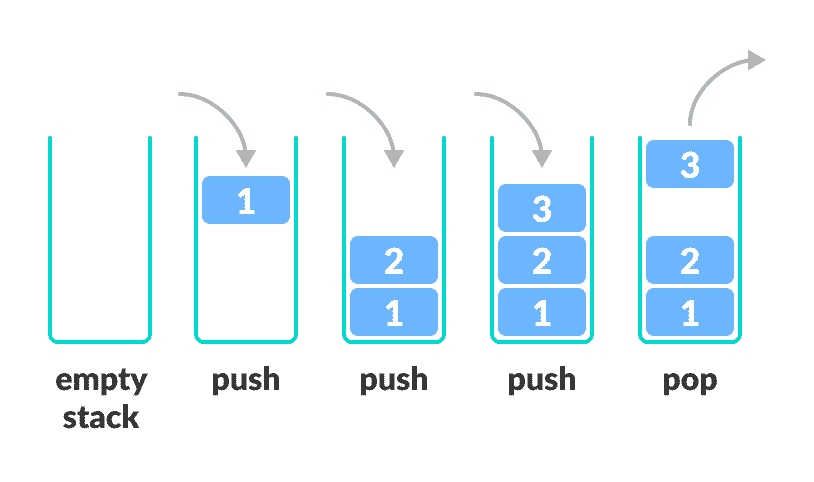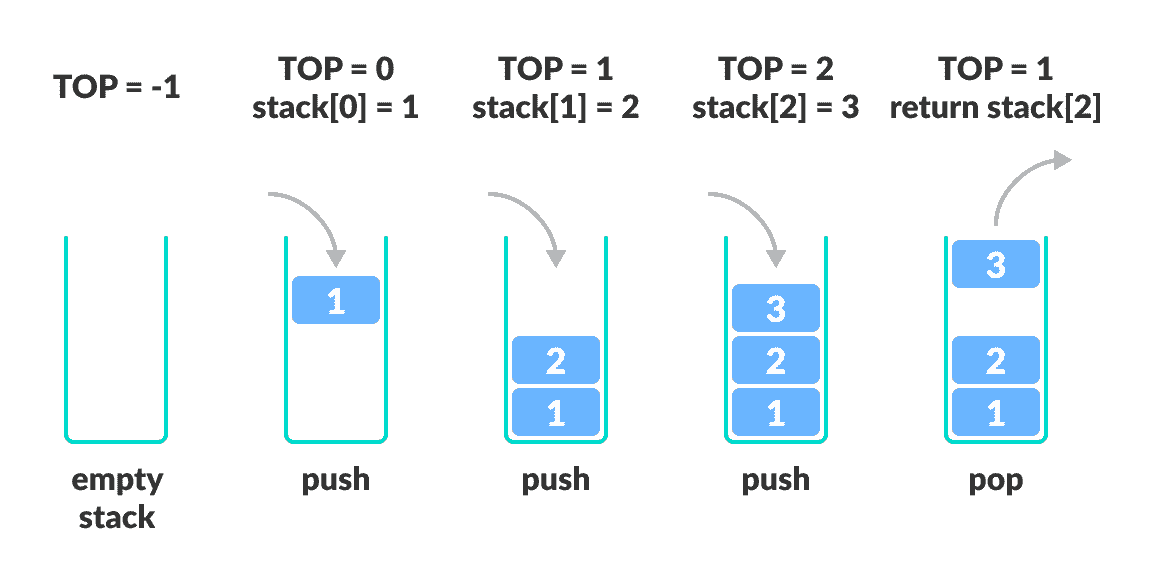在本教程中,您将学习什么是栈。 此外,您还将发现使用 C,C++ ,Java 和 Python 实现栈的实现。
栈是编程中有用的数据结构。 就像一堆板子彼此叠放。

栈表示一堆板子
想一想用这样一堆板子可以做的事情
- 在上面放一个新板
- 卸下顶板
如果要使板位于底部,则必须先卸下顶部的所有板。 这种安排称为后进先出-放置的最后一个项目是第一个要出去的项目。
编程术语中的栈
用编程术语来说,将一个项目放在栈的顶部称为“推入”,而将一个项目删除则称为“弹出”。

栈操作
在上图中,尽管项目 2 保留在最后,但它首先被移除-因此它遵循后进先出(LIFO)原则。
我们可以用任何编程语言(例如 C,C++ ,Java,Python 或 C# )实现栈,但是规范几乎相同。
栈的规范
栈是一个对象,或更具体地说,是一个允许执行以下操作的抽象数据结构(ADT):
Push:将元素添加到栈顶部Pop:从栈顶部删除元素IsEmpty:检查栈是否为空IsFull:检查栈是否已满Peek:获取顶部元素的值而不删除它
栈如何工作
操作如下:
- 称为
TOP的指针用于跟踪栈中的顶部元素。 - 初始化栈时,我们将其值设置为 -1,以便我们可以通过比较
TOP == -1来检查栈是否为空。 - 推入元素时,我们增加
TOP的值,然后将新元素放置在TOP指向的位置。 - 弹出元素时,我们返回
TOP指向的元素并减小其值。 - 推入之前,我们检查栈是否已满
- 弹出之前,我们检查栈是否已为空

栈操作
Python,Java 和 C/C++ 示例
最常见的栈实现是使用数组,但也可以使用列表来实现。
# Stack implementation in python# Creating a stackdef create_stack():stack = []return stack# Creating an empty stackdef check_empty(stack):return len(stack) == 0# Adding items into the stackdef push(stack, item):stack.append(item)print("pushed item: " + item)# Removing an element from the stackdef pop(stack):if (check_empty(stack)):return "stack is empty"return stack.pop()stack = create_stack()push(stack, str(1))push(stack, str(2))push(stack, str(3))push(stack, str(4))print("popped item: " + pop(stack))print("stack after popping an element: " + str(stack))
// Stack implementation in Javaclass Stack {private int arr[];private int top;private int capacity;// Creating a stackStack(int size) {arr = new int[size];capacity = size;top = -1;}// Add elements into stackpublic void push(int x) {if (isFull()) {System.out.println("OverFlow\nProgram Terminated\n");System.exit(1);}System.out.println("Inserting " + x);arr[++top] = x;}// Remove element from stackpublic int pop() {if (isEmpty()) {System.out.println("STACK EMPTY");System.exit(1);}return arr[top--];}// Utility function to return the size of the stackpublic int size() {return top + 1;}// Check if the stack is emptypublic Boolean isEmpty() {return top == -1;}// Check if the stack is fullpublic Boolean isFull() {return top == capacity - 1;}public void printStack() {for (int i = 0; i <= top; i++) {System.out.println(arr[i]);}}public static void main(String[] args) {Stack stack = new Stack(5);stack.push(1);stack.push(2);stack.push(3);stack.push(4);stack.pop();System.out.println("\nAfter popping out");stack.printStack();}}
// Stack implementation in C#include <stdio.h>#include <stdlib.h>#define MAX 10int count = 0;// Creating a stackstruct stack {int items[MAX];int top;};typedef struct stack st;void createEmptyStack(st *s) {s->top = -1;}// Check if the stack is fullint isfull(st *s) {if (s->top == MAX - 1)return 1;elsereturn 0;}// Check if the stack is emptyint isempty(st *s) {if (s->top == -1)return 1;elsereturn 0;}// Add elements into stackvoid push(st *s, int newitem) {if (isfull(s)) {printf("STACK FULL");} else {s->top++;s->items[s->top] = newitem;}count++;}// Remove element from stackvoid pop(st *s) {if (isempty(s)) {printf("\n STACK EMPTY \n");} else {printf("Item popped= %d", s->items[s->top]);s->top--;}count--;printf("\n");}// Print elements of stackvoid printStack(st *s) {printf("Stack: ");for (int i = 0; i < count; i++) {printf("%d ", s->items[i]);}printf("\n");}// Driver codeint main() {int ch;st *s = (st *)malloc(sizeof(st));createEmptyStack(s);push(s, 1);push(s, 2);push(s, 3);push(s, 4);printStack(s);pop(s);printf("\nAfter popping out\n");printStack(s);}
// Stack implementation in C++#include <stdlib.h>#include <iostream>using namespace std;#define MAX 10int size = 0;// Creating a stackstruct stack {int items[MAX];int top;};typedef struct stack st;void createEmptyStack(st *s) {s->top = -1;}// Check if the stack is fullint isfull(st *s) {if (s->top == MAX - 1)return 1;elsereturn 0;}// Check if the stack is emptyint isempty(st *s) {if (s->top == -1)return 1;elsereturn 0;}// Add elements into stackvoid push(st *s, int newitem) {if (isfull(s)) {printf("STACK FULL");} else {s->top++;s->items[s->top] = newitem;}size++;}// Remove element from stackvoid pop(st *s) {if (isempty(s)) {printf("\n STACK EMPTY \n");} else {printf("Item popped= %d", s->items[s->top]);s->top--;}size--;cout << endl;}// Print elements of stackvoid printStack(st *s) {printf("Stack: ");for (int i = 0; i < size; i++) {cout << s->items[i] << " ";}cout << endl;}// Driver codeint main() {int ch;st *s = (st *)malloc(sizeof(st));createEmptyStack(s);push(s, 1);push(s, 2);push(s, 3);push(s, 4);printStack(s);pop(s);cout << "\nAfter popping out\n";printStack(s);}
栈复杂度
对于基于数组的栈实现,推入和弹出操作需要固定时间,即O(1),因为在两种情况下都只有指针移动。
栈应用
尽管栈是一个易于实现的简单数据结构,但它非常强大。 栈最常见的用途是:
- 反转单词 - 将所有字母叠放并弹出。 由于栈的 LIFO 顺序,您将获得相反顺序的字母。
- 在编译器中 - 编译器使用栈通过将表达式转换为前缀或后缀形式来计算
2 + 4 / 5 * (7 - 9)之类的表达式的值。 - 在浏览器中 - 浏览器中的“后退”按钮会将您以前访问过的所有 URL 保存在栈中。 每次您访问新页面时,它都会被添加到栈顶部。 当您按下“后退”按钮时,当前 URL 从栈中删除,并访问前一个 URL。

